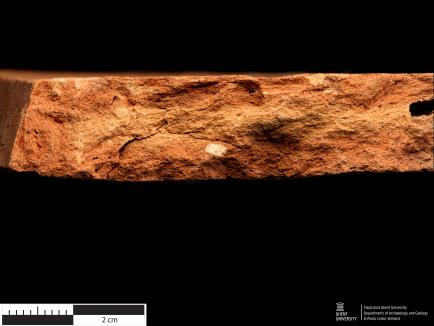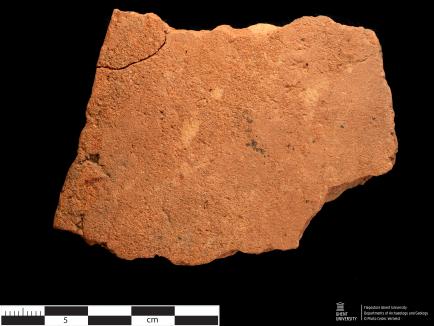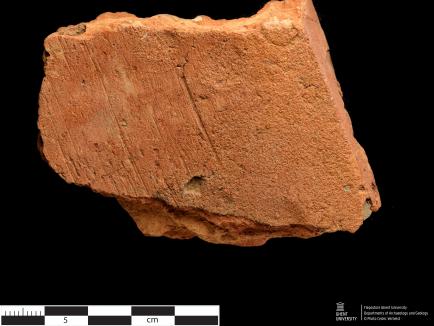Medieval - Ceramic building material (6.CBM.BE.0005)
Hand specimen pictures (macro & binocular)
Thin section pictures
Find location
- Category
- Ceramic building material (Medieval)
- Fabric name
- Chronology
- Medieval > Late Medieval > 14-15th century CE
- Dating method(-s)
- typology, stratigraphy
- Potters' mark
- No
- Additional information
- tile fragment, not sure if it was part of the kiln production
Find location
- Site type
- Pottery production
- Location
- Belgium; Vlaams-Brabant; Leuven
- Site name
- Leuven, Alfons Smetsplein
- Excavation or Survey Team
- Ruben Willaert bvba, Afdeling archeologie; J. De Gryse & J. Ooms
- Additional contextual information
- site code: LE-06-HPL; CAI code: 1999; feature S45, filling of the partially conserved kiln (tile/rooftile level); this tile fragment was probably not a product of the kiln
- Slip
- No
- Slip color
- Glaze
- No
- Glaze type
- Glaze color
- Glaze additives
- Additional information
- Surface color
- orange
- Surface texture
- Rough
- Fracture color
- orange
- Inclusions (non-plastics/tempering)
- quartz (rare grains up to 1 mm); red and beige inclusions (1-3 mm) (grog ?)
- Matrix and voids
- small vesicles
- Diagnostic features
- Additional information
- sample LE_HPL_ST2
- Flepostore inventory nr.
- ARCH1.L1.A22
- Original inventory nr.
- A0012
- Collection
- Archaeological Department, Ghent University
- Type
- Covered thin section
- Comparable thin section(s)
- Matrix
-
Oxidized red fabric; redbrown (PPL), dark brown and yellow/orange brown (XP).
Heterogeneous matrix, non-calcareous with medium to high optical activity.
- ca. 60-75% - Inclusions
-
Quartz (++; cf: mono, r, medium - coarse sand; ff: mono, poly, r-sr, very fine to fine sand; bimodal), sedimentary rock detritus (+-; ff, possible quartz arenite), chert/flint (+-; ff & cf), muscovite mica (+-; el, ff), feldspars (--; orthoclase, microcline), glauconite (+-; red in PPL, r, ff), pyroxene (--; r, ff), O/Fe (+; ff & cf), semi-plastics/clay pellets (+; various compositions*)
The coarse fraction varies from coarse to medium sand, the fine fraction from fine sand to very fine sand. Coarse fraction grains are generally rounded, fine fraction grains are generally rounded to subrounded. Bimodality of quartz population, iron oxides and semi-plasics/clay pellets (possibly natural). Overall the fabric is moderately to poorly sorted.
- ca. 20-30% - Voids
-
Small planar voids and larger vughs with good alignment parallel to the edge, no infill. Drying cracks in and around semi-plastics/clay pellets.
- ca. 5-10% - Diagnostic features
- The fabric is characterized by a heterogeneous oxidized matrix with medium to high optical activity and low porosity. Dominant quartz inclusions with common sedimentary rock detritus, chert/flint, muscovite mica, glauconite, opaques/iron oxides and semi-plastics/clay pellets of various compositions, and rare feldspars and pyroxene. Bimodality in quartz population, unclear if it represents a natural sandy fraction or an added temper. The various plastic inclusions most likely result from poor mixing of various clays or clay layers, or can represent a temper of dried and/or fired material. Overall moderately to poorly sorted.
- Additional information
- *Semi-plastics/clay pellets: 1. iron-rich semi-plastics; 2. iron-poor clay zones; 3. reduced zone (grey) rich in quartz; 4. argillaceous/grog inclusions: oxidized, orange body color in PPL, dark yellow in XP, medium to high optical activity, very fine matrix (ca. 80-90%) with monocrystalline quartz (+; r-sr), muscovite mica (-; el), iron oxide (-); clear boundaries, rounded, neutral optical density, concordant features); similar to inclusions in A0011. Most likely the result of poor mixing of two clays or a clay with layers consisting of different compositions. Possible addition of dried or fired material (n°3 & 4 = grog temper?).
- Sample type
- Building material (decorative, construction)
- Inventory number
- 6.CBM.BE.0005
- Collection
- Archaeological Department, Ghent University
- Donating institute/person
- Onroerend Erfgoeddepot Vlaams-Brabant-LOODS 68
- Host collection
- Onroerend Erfgoeddepot Vlaams-Brabant-LOODS 68
- Other samples available
- Yes
- Sample collection method
- Archaeological Excavation
De Gryse & Ooms 2007
- Full reference
-
De Gryse J. & Ooms J. 2007 Archeologisch onderzoek op het A. Smetsplein (Leuven). Onuitgegeven opgravingsverslag Ruben Willaert Bvba. Afdeling archeologie, Damme: 67.
Cite this page as: Flepostore - https://flepostore.ugent.be/ceramics/6-cbm-be-0005
Last modified: 2024-04-23.








